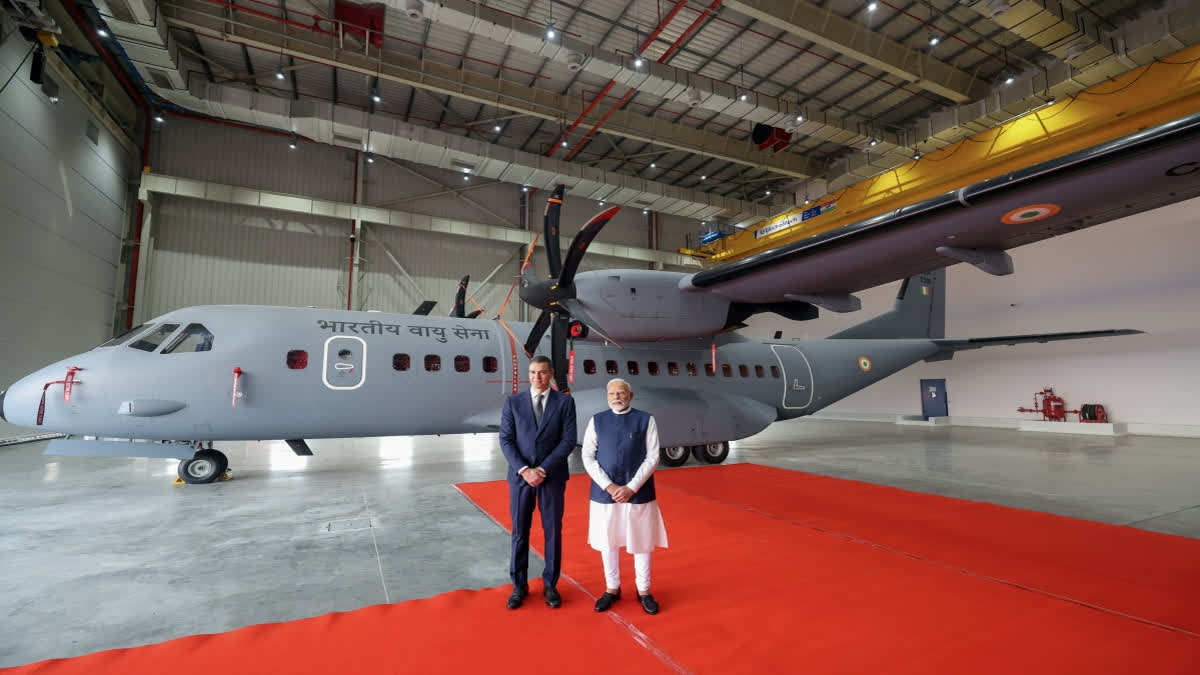New Delhi: Though the highlight of Spanish Prime Minister Pedro Sanchez's ongoing visit to India was the joint inauguration with Prime Minister Narendra Modi of the C-295 aircraft manufacturing facility in Vadodara on Monday, the two sides also signed a memorandum of understanding (MoU) on cooperation in rail transport.
"The two leaders expressed satisfaction at the signing of a memorandum of understanding on cooperation in the field of rail transport and the agreement of cooperation and mutual assistance in customs matter," a joint statement issued following delegation-level talks headed by Modi and Sanchez reads.
The MoU on rail transport was signed for cooperation in planning, design, development, commissioning and operation of infrastructure, stations, railways facilities and equipment of long-distance passenger and freight networks as well as urban and regional railway systems.
Monday’s MoU is actually a furtherance of the already existing cooperation between India and Spain in rail transport. This cooperation actually started in the early 2000s given Spain’s expertise in high-speed rail and railway infrastructure.
Rail transport in Spain
Rail transport in Spain operates on four rail gauges and services are operated by a variety of private and public operators. The total railway length in 2020 was 15,489 km (9,953 km electrified). The Spanish high-speed rail network is the longest such network in Europe with 3,966 km and the second longest in the world, after China's.
Most railways are operated by Renfe Spain's national state-owned railway company. Metre and narrow-gauge lines are operated by the Renfe Cercanias AM division. Local publicly-owned operators include Euskotren in the Basque Country, FGC in Catalonia and Serveis Ferroviaris de Mallorca in the Balearic Islands. Private railway operators include Ouigo and Iryo.
It is proposed and planned to build or convert more lines to standard gauge, including some dual gauging of broad-gauge lines, especially where these lines link to France, including platforms to be raised.
High-speed rail was first proposed in Spain in the 1980s, joining Meseta Central and Andalusia. The first line, joining Madrid and Seville, was opened in 1992, in time for the Seville Expo ’92. The line was built on standard gauge and reused segments of the existing Madrid-Ciudad Real line. After that, connections with Barcelona, Valencia, Malaga and Galicia were subsequently opened.
The network sees a multitude of services, operated by three companies under a multitude of brands. Renfe operates services under the AVE brand for high-speed long-distance services, AVANT for high-speed mid-distance, and ALVIA and Euromed for services that change gauges. The French operator SNCF runs international services under the inOui brand and national services under the Ouigo low-cost brand. Iryo operates several high-speed services.
India-Spain cooperation in rail transport
Formal cooperation in rail transport between India and Spain began in the early 2000s when India launched initiatives to modernise and expand its railway network. AVE, Spain's high-speed rail network is known for its technological innovation and operational efficiency. This experience has been particularly valuable to India as it seeks to develop its own high-speed rail network and improve its existing infrastructure. Initial collaboration efforts were driven through bilateral agreements, technical exchanges, and partnerships between Indian and Spanish rail companies.
One of the most significant areas of cooperation is in high-speed rail technology. Spain's expertise in designing, operating, and maintaining high-speed rail systems has made it a valuable partner for India. Spanish companies, notably the state-owned railway company RENFE and infrastructure development firms like ADIF, have actively engaged with Indian counterparts to share knowledge and best practices.
In 2017, India and Spain signed a technical cooperation agreement to develop rapid rail transit systems (RRTS) in the National Capital Region (NCR) of India.
"Signed between India's National Capital Region Transport (NCRTC) and Spain's Administrador de Infraestructuras Ferroviarias (ADIF), the contract will enable cooperation on the technical development of track, signalling, rolling stock, safety, multi-modal integration, and station design," a posting on the railway-techology.com website reads.
"The deal is also expected to enhance the availability of technical advice on specific issues concerning project implementation and the provision of training to associated personnel."
Spain's advanced railway signaling and electrification technologies are key contributions to India's rail modernization efforts. Spanish firms have collaborated with the Indian Railways to implement modern signaling systems and introduce automated control systems that improve safety and efficiency. This partnership also extends to electrification projects, as India aims to electrify its entire rail network by 2030. Spanish technology in electrification, particularly for high-speed rail and long-distance trains, aligns with India's sustainability goals by reducing its reliance on diesel locomotives.
India and Spain have cooperated on rolling stock and train manufacturing, with Spanish companies working alongside Indian manufacturers to produce modern train components and carriages. Talgo, a Spanish train manufacturer, conducted trial runs of its lightweight, high-speed trains on Indian tracks in 2016. Talgo’s trains demonstrated faster travel times between Delhi and Mumbai, offering insights into the potential benefits of lightweight trains for India’s rail network. Although these trials did not immediately lead to full-scale adoption, they showcased Spanish technology and strengthened the foundation for future collaborations.
Major India-Spain railway collaborative projects
Although Japan is the primary partner in the Mumbai-Ahmedabad high-speed railway project, Spain has contributed technical insights and consultancy services. Spanish companies provided expertise on feasibility studies, track design, and maintenance planning, complementing Japan’s efforts and enhancing the project’s technological framework.
Spanish firms are also involved in the construction and management of rapid transit systems in India, such as the Delhi-Meerut RRTS, which aims to reduce congestion and improve connectivity in NCR. Spain's experience with commuter rail networks is useful in planning and operational strategies.
Spain's extensive experience with freight corridors is also useful for India's development of dedicated freight corridors, which are intended to separate passenger and freight traffic, thereby increasing the efficiency of both. Spanish companies have provided consultancy services on logistics and operational planning for these corridors.
To sum up, the economic benefits of this cooperation are significant for both countries. India gains access to Spanish expertise in high-speed and modern rail technologies while Spanish companies gain access to a large and growing market in India, which has created new business opportunities and revenue streams. This collaboration also supports India's 'Make in India' initiative, as Spanish firms work with Indian manufacturers to localise components and produce trains domestically.



